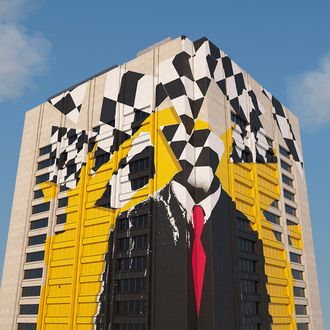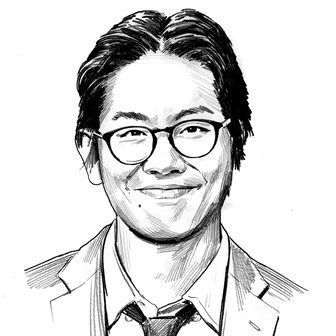
It’s such a pleasure to listen to Serial again. The podcast’s highly anticipated third season opens, as it always does, with Sarah Koenig’s narration, once again lyrical and surprising and wildly economical. Koenig, who will split hosting duties this season with This American Life staffer Emmanuel Dzotsi, takes just under 25 seconds in the opening minutes to vividly establish Cleveland’s Justice Center, which serves as the hub of stories for the season.
“The Justice Center houses, in location, everything a justice system needs,” she narrates. “The city and county courts, the county jail, the prosecutor’s offices, the Sheriff’s office, and headquarters for the Cleveland police. Roughly speaking, the building functions like most hierarchies: Vertically, in this case, from the bowels up. The main court tower is 26 stories high, so the elevator really runs the place.”
The ding of elevators, the crunch of boots, the implicit power of the building’s literal structure: These are the little details that turn a setting into a scene, a place into a world. Serial presents the Justice Center as an intense web of detail with characters, codes, histories, relationships, ugly buildings, an entire universe unto itself. Lawyers clash, collude, and commiserate with judges, clients, and each other. Deals are cut and sentences negotiated in sometimes illogical and unfair ways. (A judge’s relative may get a lighter sentence than a non-relative for the exact same crime, for example.) The Justice Center might serve as the bureaucratic layer for the city of Cleveland, but as we’re introduced to its hallways and brutalist architecture, the world contained within can feel strange and obscene to the citizens outside of it.
The surreality is often key to crime journalism, novels, documentaries, podcasts, and legal dramas like The Good Fight. These works find value in mining the gap between how the world works and how we think it works — or rather, how we think it should work. (Of course, the question of who constitutes the “we” is always and rightfully a subject of debate, meditation, and criticism.) But the most noteworthy of these works tend to deal with extraordinary cases in order to bring attention to the strangeness and the failures of the systems that are meant to support us. In The Dark’s second season is a representative example of this, as its case revolved around a black man in Mississippi who was tried six times by the same white attorney for a crime he might not have committed. But while those stories are usually attention-grabbing, anger-provoking, and painfully salacious, there may well be distinct limits to what they actually tell us about the criminal justice system. After all, issues aren’t always defined by their edge cases, in much the same way that people aren’t always defined by their highest of highs or lowest of lows.
That conundrum drives this new Serial season, which immediately evokes its own contribution to the mess given the insane surprise popularity of its original 2014 run. “People have asked me and the people I work with the question: What does this case tell us about the criminal justice system?” host Sarah Koenig narrates in the opening minutes. “Fair question. The answer is that cases like that one, they are not what fills America’s courtrooms everyday.” She goes on to explain that Adnan Syed, the imprisoned Baltimore man at the center of Serial’s first season, was charged with a first-degree murder with no prior criminal record, that his family hired an expensive lawyer, and his case eventually went to trial — an extremely rare occurrence. By virtue of its extraordinariness, Koenig argues, Syed’s case can tell only us so much.
So the Serial team pivots from taking up another extraordinary case — as they did again with the second season, which centered on the mysterious kidnapping of Army Sergeant Bowe Bergdahl in Afghanistan — and shifts its focus towards documenting, decoding, and dissecting the ordinary everyday of the American criminal justice system using Cleveland as its site of investigation. It offers up a prismatic view of the world through one specific courtroom, week after week. (The choice of city, by the way, was driven less by intentionality than by sheer opportunity; it was the only city that allowed the Serial team unfettered access.) From the sounds of the first episode, which was provided to Vulture for review, there’s nothing ordinary about how things work in the system on a day-to-day basis. Either that, or “ordinariness” is a lie we tell ourselves over and over again to keep our collective sanities intact.
You could draw a thematic line between this new season and S-Town, Serial’s novelistic spinoff from last year. Speaking to the Longform podcast, creator Brian Reed regarded S-Town as an effort to tell “a story about the remarkableness of what could be called an unremarkable life.” A similar enterprise animates Serial’s turn toward Cleveland. The first episode digs into what seems like a fairly pedestrian case: a white woman accidentally punched a cop in a bar, and now she’s being brought to court. But as the show unpacks the story, piece by piece, we’re shown not only the unexpected complexity of the woman’s legal pathway, but the unexpected complexity of the actual incident. (She was being harassed by male bar patrons, a confusing tussle ensued, and a veritable multiverse of social dynamics exploded within a confined space.) Her story ends, at least for now, in a place you didn’t necessarily expect the story to go, but it’s a place that you won’t exactly be surprised to discover.
Given the season’s focus on the American criminal justice system writ large, race is everywhere, even when it isn’t. We’re told at the outset that the Justice Center is socially structured with deep racialized power; that is, the people running the system tend to be white, and the people being subjected to the system tend to be disproportionately black. There’s a particularly memorable sequence in the episode’s introductory stages during a brief scene in an elevator that squeezes those two layers against each other; separate but equal, ample wariness in-between. In the white woman’s story that centers the first episode, you’re clearly made to see what her whiteness affords her and, conversely, what it doesn’t.
Serial begins its third season with considerable baggage. The team appears to be shouldering not just enormous expectation and ambition — I’ve spoken to more than a few people have compared the premise of new season’s premise to The Wire, which isn’t particularly accurate, but still hefty — but also the weight of its own shadow. The first season continues to loom over the podcast almost four years after its debut: the true-crime affiliation, the collective and ethically complicated obsession, the SNL skit. It seems pretty clear to me that the team will probably not be able to shake that off, and it also seems clear to me that this new season, given the complexity of its goal, will probably not hit the same highs as that first phenomenal run. The ingredients simply aren’t there: There’s no surging central mystery, no drive towards possible resolution, no true-crime stickiness. But if it does hit a major high, it will be according to a completely different set of terms.
At its peak, the first episode of this season fuses together two kinds of highs: the dopamine hit of a really good journalistic study, and the warm pitter-patter of a workplace drama. Between the richness of the script and the scale of its scope and the crispness of its execution — did I mention that the revamped theme song is just delicious this season? — Serial’s third season is off on a fantastic start. I can’t wait for more.


